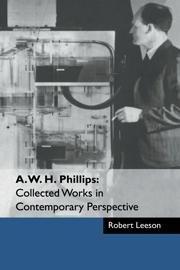Book contents
- Frontmatter
- Contents
- List of contributors
- Foreword by Arthur Brown
- Preface by Robert Leeson
- Part I Bill Phillips: Some Memories and Reflections
- Part II The Phillips Machine
- Part III Dynamic Stabilisation
- Part IV Econometrics
- 36 The Bill Phillips legacy of continuous time modelling and econometric model design
- 37 The published papers
- 38 The influence of A.W. Phillips on econometrics
- 39 An appreciation of A.W. Phillips
- 40 Some notes on the estimation of time-forms of reactions in interdependent dynamic systems
- 41 Cybernetics and the regulation of economic systems
- 42 The estimation of parameters in systems of stochastic differential equations
- 43 Estimation, regulation and prediction in interdependent dynamic systems
- 44 The Walras-Bowley Paper
- 45 Estimation of systems of difference equations with moving average disturbances
- 46 The estimation of continuous time models
- 47 Estimation in continuous time series models with autocorrelated disturbances
- 48 Efficient fitting of rational spectral density functions and transfer functions
- 49 The Lucas Critique: did Phillips make a comparable contribution?
- 50 Models for the control of economic fluctuations
- 51 Statistical estimation for the purpose of economic regulation
- 52 The last paper: a foreshadowing of the Lucas Critique?
- References
- Index of names
- Index of subjects
50 - Models for the control of economic fluctuations
Published online by Cambridge University Press: 04 May 2010
- Frontmatter
- Contents
- List of contributors
- Foreword by Arthur Brown
- Preface by Robert Leeson
- Part I Bill Phillips: Some Memories and Reflections
- Part II The Phillips Machine
- Part III Dynamic Stabilisation
- Part IV Econometrics
- 36 The Bill Phillips legacy of continuous time modelling and econometric model design
- 37 The published papers
- 38 The influence of A.W. Phillips on econometrics
- 39 An appreciation of A.W. Phillips
- 40 Some notes on the estimation of time-forms of reactions in interdependent dynamic systems
- 41 Cybernetics and the regulation of economic systems
- 42 The estimation of parameters in systems of stochastic differential equations
- 43 Estimation, regulation and prediction in interdependent dynamic systems
- 44 The Walras-Bowley Paper
- 45 Estimation of systems of difference equations with moving average disturbances
- 46 The estimation of continuous time models
- 47 Estimation in continuous time series models with autocorrelated disturbances
- 48 Efficient fitting of rational spectral density functions and transfer functions
- 49 The Lucas Critique: did Phillips make a comparable contribution?
- 50 Models for the control of economic fluctuations
- 51 Statistical estimation for the purpose of economic regulation
- 52 The last paper: a foreshadowing of the Lucas Critique?
- References
- Index of names
- Index of subjects
Summary
For the last two decades the governments of most Western countries have been carrying out some degree of conscious control over their economies with the purpose of overcoming the severe fluctuation in the general level of economic activity and employment which plagued all free enterprise countries for a century or more before the First World War and which reached catastrophic proportions in the inter war years. A fair degree of success has been achieved. In Britain the range of variation in unemploy- ment since the last war has been about 2 per cent, compared with about 10 per cent in the typical cycles of the century before the First World War and more than 20 per cent in the interwar period. The range of the percentage variation in total output about its trend has, however, been greater; about 8 per cent, or four times that of unemployment. This degree of success is probably sufficient to permit the survival of free enterprise economic systems and democratic forms of government, but further improvement is clearly desirable.
The results of research in model building and econometric estimation are being used by government departments, though as yet in a rather rudimentary way, in the practical task of controlling economic fluctuations.
- Type
- Chapter
- Information
- A. W. H. Phillips: Collected Works in Contemporary Perspective , pp. 468 - 474Publisher: Cambridge University PressPrint publication year: 2000
- 1
- Cited by



